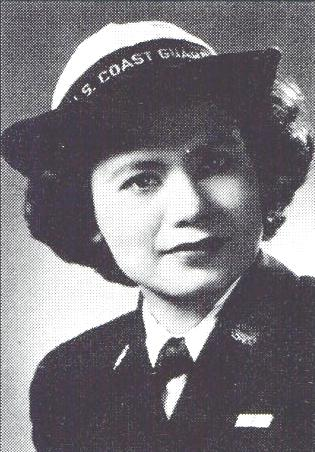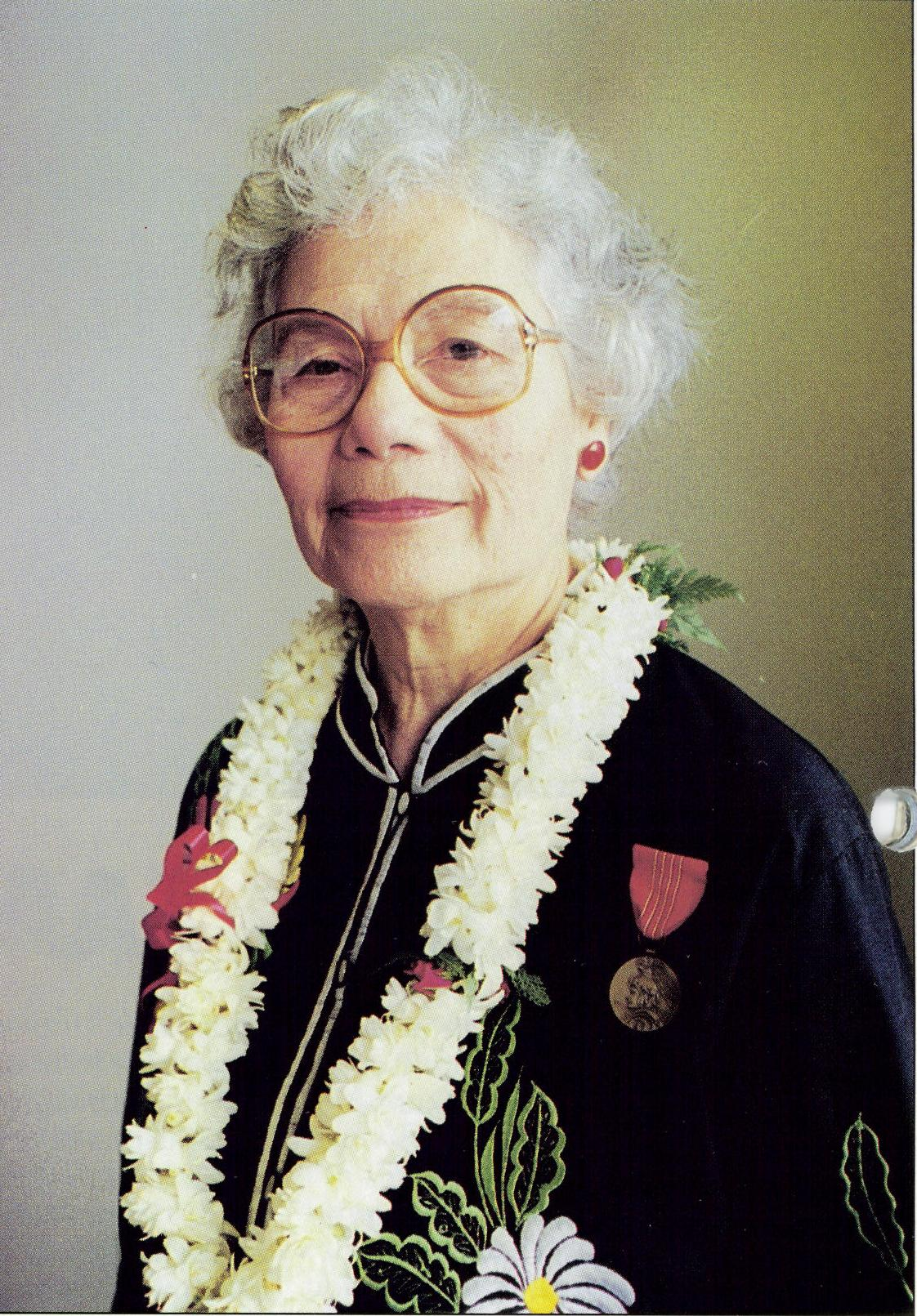Last updated: November 2, 2023
Article
Florence Finch

Courtesy of the United States Coast Guard
Florence Eberling Smith Finch was a woman who stood up for her convictions in the face of overwhelming odds. She aided United States military intelligence and the Philippine resistance movement during World War II. She provided supplies to prisoners of war (POWs) in Manila when the Japanese occupied the island, and she survived arrest and interrogation. Upon her release in October 1944, she joined the US Coast Guard. Her efforts broke barriers for Asian American women in the armed forces.
“She displayed outstanding courage and marked resourcefulness in providing vitally needed food, medicine and supplies for American Prisoners of War and internees, and in sabotaging Japanese stocks of critical items … constantly [risking] her life in secretly furnishing money and clothing to American Prisoners of War and carrying communications for them.” – Lt. Col. Edward C. Engelhart, Commendation for Florence Finch to receive the Medal of Freedom. [1]
Early Life in the Philippines
Finch was born Loring May Ebersole in Santiago, in the Isabela Province of the Philippines in 1915. Her mother was Filipina. Her father was a white US Army veteran who had fought in the American takeover of the island during the Spanish-American War. She attended a boarding school for mixed-race girls and the school gave her the name Florence.
Her first job was as the assistant business manager at the Army/Navy YMCA, where she met her first husband, Chief Electrician’s Mate Charles Smith. The couple married in August 1941, before the US entered World War II. When the war started, Smith deployed on a patrol torpedo (PT) boat to defend the Philippines from Japanese invasion.
Shortly after meeting Smith, Finch transferred to a new job in US Army Intelligence. Finch assisted Major (later Lt. Colonel) Edward C. Engelhart, the second in command at G-2, or Intelligence, branch of US Army Headquarters in the Philippines. When the US government evacuated Army Intelligence staff from Manila to protect them from Japanese invaders, Finch stayed behind to care for her 16-year-old sister. Manila fell to the Japanese in January 1942. The Japanese rounded up American and British residents and put them in internment camps [2]. Finch used her Filipino citizenship to avoid arrest.
Her husband, Charles Smith, died in combat in February of 1942 during the Japanese invasion of the Bataan Peninsula.

"Freed Army Nurses Leaving Manila in 1945." U.S. Army. Courtesy of Women of World War II.com
Resistance and Capture
During the Japanese occupation, Finch resisted in two important ways. She worked for the Japanese-controlled Philippine Liquid Fuel Distribution Union. Because of her secretarial skills, she oversaw writing names on fuel ration cards. During this time, she wrote fake names for the Filipino resistance on the cards. Members of the resistance could use the cards to get necessary food and other supplies without revealing their identities to Japanese officials. Historians now estimate that she sent as much as 250 gallons of fuel a week to the Filipino resistance [3].
Finch also helped American and British POWs. When the Japanese captured her former supervisor, Lt. Col. Engelhart, he got word to her about the conditions of the prisoners in Bilibid Prison and Santo Tomas camps. Finch helped smuggle food and medicine to the prisoners, often using proceeds from the stolen fuel. She also did other things to help make their lives more comfortable, like providing clean laundry.
The Japanese arrested Florence Finch in October of 1944. They interrogated and tortured her. Finch was imprisoned first in Bilibid and then in Mandaluyong Women's Prison. When American forces liberated the prison in February 1945, Finch weighed under 85 pounds. She did not give up any information to the Japanese military.

Courtesy of the United States Coast Guard
Becoming a SPAR
Finch traveled to the US mainland on a Coast Guard transport. She moved to her father’s hometown of Buffalo, New York. Still hoping to help the war effort, she enlisted in the US Coast Guard Women’s Reserve (SPARS) program in July 1945. Later, Finch said she had never heard of the Coast Guard before but wanted to “avenge the death of her husband.” [4] She was one of the first Asian American women to enlist as a Spar. World War II ended shortly after she joined the Coast Guard.
Legacy
Florence Finch was the first woman to earn the Asiatic-Pacific Campaign Ribbon. In 1947, based on reports from former US POWs, President Harry S. Truman awarded her the Medal of Freedom.
“I feel very humble because my activities in the war effort were trivial compared with those of people who gave their lives for their country.” –Florence Ebersole Smith Finch [5]
When the war ended, she stayed in New York City as part of the SPARS. There she met her second husband, Robert Finch. They moved to Ithaca, New York, where Finch was an administrative secretary at Cornell University. She had two children.
In 1995, the Coast Guard named the administration building at the Coast Guard Base in Honolulu after her and a Fast Response Cutter in her honor in 2022.
Finch died in Ithaca, New York in 2016 at age 101.
This article was written by Alison Russell, a Consulting Historian with the Cultural Resource Office of Interpretation and Education and funded by the National Council on Public History's cooperative agreement with the National Park Service.
[1] Quoted in Thiesen. “The Long Blue Line; Florence Finch—Asian-American SPAR and FRC namesake dons uniform 75 years ago!” United States Coast Guard.
[2] This is a different type of imprisonment than the incarceration camps that the US government relocated Japanese and Japanese Americans to. Internment is a term in international law to refer to camps where enemy soldiers are imprisoned during war. Based on this definition and the input of the community, NPS and other scholarly communities now use the term “incarceration camp” to refer to the places Japanese and Japanese Americans were imprisoned in the United States. For more information on the difference between the two, see the NPS guide to Terminology and the Mass Incarceration of Japanese Americans during World War II.
[3] Sandy Levins “Hidden WWII Hero: Filipina-American Florence Finch.” Wednesday’s Women, May 2021.
[4] “Florence Ebersole Smith Finch, USCGR” United States Coast Guard. Florence Ebersole Smith Finch, USCGR > United States Coast Guard > All
[5] “Florence Ebersole Smith Finch, USCGR” United States Coast Guard. Florence Ebersole Smith Finch, USCGR > United States Coast Guard > All
Levins, Sandy. “Hidden WWII Hero: Filipina-American Florence Finch.” Wednesday’s Women, May 2021. Hidden WWII Hero: Filipina-American Florence Finch - WednesdaysWomen
McKelvey, Tara. “A Woman Who Resisted the Japanese Military.” New York Times, July 2020. A Woman Who Resisted the Japanese Military - The New York Times (nytimes.com)
Mrazek, Robert J. The Indomitable Florence Finch: The Untold Story of a War Widow Turned Resistance Fighter and Savior of American POWs. Hatchett, 2020.
Oral History Interview for Ms. Florence Finch, Ithaca, New York, 2007 (SPAR, Medal of Freedom recipient, worked in Gen. MacArthur’s intel division in Philippines) Segment 1: For the Record: (uscg.mil)
Roberts, Sam. “Florence Finch, Unsung War Hero who took on the Japanese, Dies at 101.” New York Times, April 2017. Florence Finch, Unsung War Hero Who Took On Japanese, Dies at 101 - The New York Times (nytimes.com)
Thiesen, William H. “Florence Ebersole Smith Finch, USCGR (W).” U.S. Coast Guard Historian’s Office. Florence Ebersole Smith Finch, USCGR > United States Coast Guard > All
Tags
- aapi
- world war ii
- aapi heritage
- aapi history
- philippines
- world war 2
- wwii
- ww2
- military history
- women at war
- spar
- women's history
- pow
- world war ii women breaking barriers
- filipino
- filipino american
- filipino american history
- filipino resistance
- women in world war ii
- coast guard
- new york
- medal of freedom
- women in the military
- military and wartime history
- wwii home front
- world war ii home front
- us coast guard
- spars
